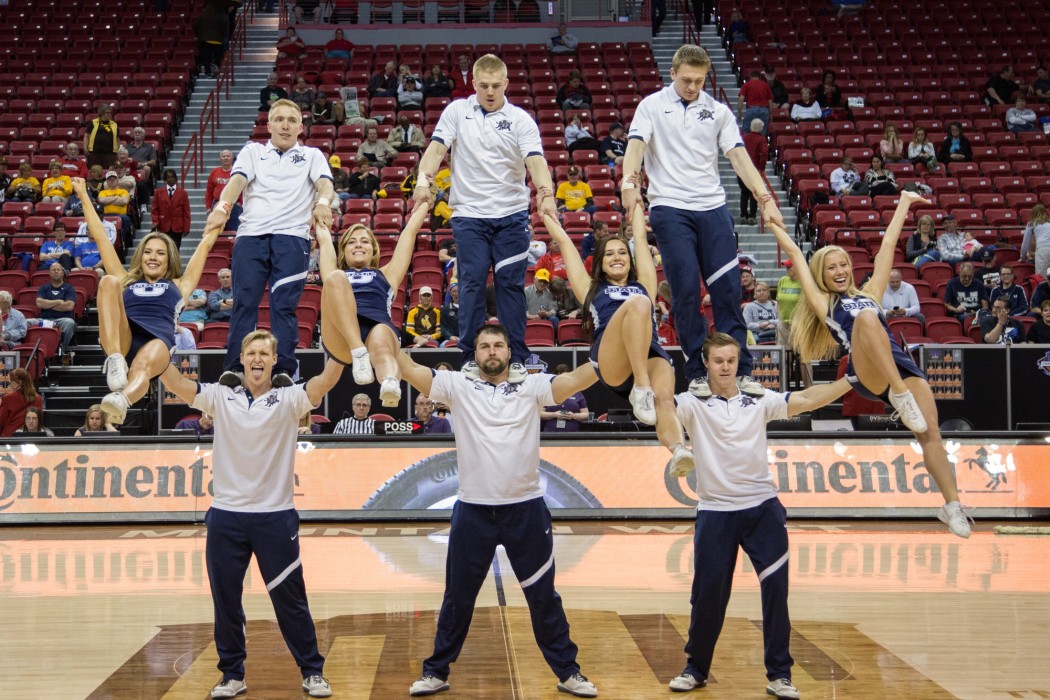What I learned trying to be a cheerleader
With a bruised body, sore shoulders and lethargic legs, I made my way to center court of the Spectrum for my tryout to be part of the USU spirit squad.
The journey began four weeks earlier sitting on a bus full of cheerleaders as I quietly prepared for the eight-hour drive from Logan to Las Vegas.
On the way down, I chatted with spirit squad members and coaches, mostly small talk and getting to know one another. But then, something else began to happen. A few members of the squad told me to try out. Confidently I told them this wasn’t a reality because I knew nothing about cheering.
As the trip went on, a few of my writing advisers and peers kept the joke going until I cracked and committed to it. Two days into the trip, I broke protocol and social stereotypes. I showed up to the cheer practice for the Mountain West Tournament halftime show.
At practice, the cheer squad broke some stereotypes of its own. I had generally viewed cheerleaders as the super popular, too-cool-to-talk-to-me type of group. However, they were all very inclusive, eager for me to join in and become part of the group. They even had me hop in the group photo of all the cheer squads in the MW. That’s when I committed. There was no turning back from my decision to try out for the cheer squad.
Once I was back, I began my training regimen. Gym visits with Jesse White were the beginning. Jesse is a senior member of the squad — and the most ripped — so naturally he seemed like the best person to help me out. Obviously with three weeks to go until tryouts, I wasn’t going to put on much muscle mass, but that didn’t stop us from trying.
After the gym, I began attending the open-gym sessions at High Point Gymnastics to put in some work on the stunts. I feel bad about some of the time there — I definitely bruised a lot of the cheerleaders as I tossed them into the air, didn’t catch their feet right and collapsed beneath them.
Don’t worry, there were people spotting to help me not injure anyone but still, I’m pretty sure they had it worse than me. At times, I would launch them up and a little backwards, so they just toppled right over me into the waiting arms of a spotter behind. Finally though, I got to the point where I can flick someone into the air and catch their feet in my hands. It’s still not super pretty or consistent but I can do it.
After my first week of training, I didn’t know if I would be able to walk again. My back hurt, my legs were sore and my entire body had bruises and scrapes in the pattern of shoe prints. At this point, I had to take some time off for wisdom teeth surgery but I was back tossing people within six days.
The next two weeks were filled with extra practices with Jesse and some other members of the squad to prepare me for tryouts. By the time the day arrived, I was exhausted.
At tryouts, I met new people and had a really good time. Starting out, I felt a little out of place as I looked around and realized everyone was better than me, but that went away as I realized nobody else cared. I did my stunt, a toss to hands and extension. I struggled a little bit on the catch but got everything else the best I had ever done.
Even though I got cut, I did my best and learned some valuable lessons.
What stood out the most is that cheering is quite physically demanding. What those guys and girls make look simple actually takes a ton of strength. I don’t know how many times I heard “It’s not about strength, it’s all in the technique,” but that’s a lie. Technique helps but if your shoulders are the size of large watermelons and your legs are as big as a fully grown tree, you’ve got a huge advantage.
I also noticed the interesting stereotypes involved with cheering, especially male cheerleaders. Sometimes when I told people I had to leave for cheer practice they laughed, made fun of me for a while and then realized I wasn’t joking. Those people can say what they want but it was really fun and I enjoyed it a lot. I also learned that most of the “popular,” “stuck-up,” “rich,” “perfect” and whatever else we’ve all heard them called, cheerleaders are quite nice. They are just normal people, with normal problems and lives just like the rest of us.
The most important thing I learned from my experience, is that the spirit squad is a big family. Although I didn’t fit the stereotypical mold as someone extremely popular, cool or insanely jacked, it didn’t matter. People were nice to me for who I was. I felt accepted by the people on the team and like part of the family.
— Kalen is a junior majoring in broadcast journalism and Spanish. He really enjoyed trying out for the cheer squad and may do so again next year. If you have questions or comments reach him via email at kalen.s.taylor@gmail.com or on Twitter: @kalen_taylor.


Great article Kalen. I guess you weren’t joking when you told me you were trying out. Thank you for the insight!